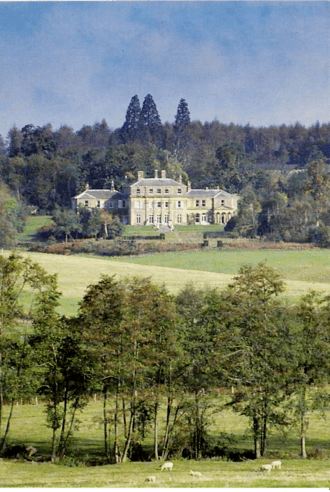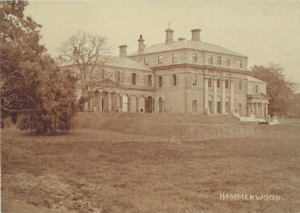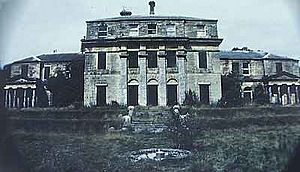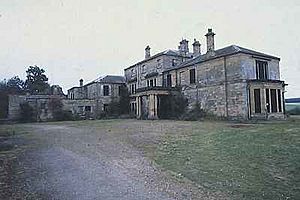Hammerwood Park facts for kids
Quick facts for kids Hammerwood Park |
|
|---|---|
 |
|
| Former names | Hammerwood Lodge |
| General information | |
| Type | English country house |
| Architectural style | Greek Revival, Doric |
| Town or city | Hammerwood, East Grinstead |
| Country | |
| Construction started | 1792 |
| Completed | c. 1795 |
| Design and construction | |
| Architect | Benjamin Henry Latrobe (1764–1820) |
| Lua error in Module:Location_map at line 420: attempt to index field 'wikibase' (a nil value). | |
|
Listed Building – Grade I
|
|
| Designated | 26 November 1952 |
| Reference no. | 1191730 |
| Type | Grade II |
| Designated | 25 March 1987 |
| Reference no. | 1000306 |
Hammerwood Park is a beautiful old country house located near East Grinstead in East Sussex, England. It is a very important historical building, listed as a Grade I building. This means it is considered to be of exceptional interest.
Hammerwood Park was one of the first houses in England built in the Greek Revival style. This style copies the look of ancient Greek temples. It was built in 1792 by Benjamin Henry Latrobe, who later became a famous architect in America. The house was even owned by the famous rock band Led Zeppelin from 1973 to 1982!
Contents
The History of Hammerwood Park
Early Days: Before 1792
The land where Hammerwood Park stands was once part of a larger estate called The Bower. This name might have come from a family who lived there long ago. In the 1500s, a family called Botting started an iron forge nearby. An iron forge was a place where metal was heated and shaped.
Later, in 1693, some of the trees were cut down to clear space for an older house on the site. This area was probably a deer park in medieval times. Foundations of an older building have been found under the current house. This suggests a main house stood there before Hammerwood Park was built.
Building Hammerwood Lodge: 1790s
Around 1791 or 1792, a wealthy man named John Sperling asked architect Benjamin Henry Latrobe to design a new country house. Sperling wanted a hunting lodge, like the Jagdschloss (hunting castles) found in Germany. He decided to call the new house Hammerwood Lodge. This name was likely a nod to the iron forge that used to be in the area.
Latrobe started supervising the building work in late 1792. The house was designed to look grand, with a large central part and smaller wings on the sides. It featured special stone plaques with scenes from an ancient Greek vase. The design was inspired by ancient Greek temples.
By 1795, Latrobe faced money problems and moved to America. It's thought that the Sperling family finished the house without him. However, the Sperlings also lost a lot of money from a bad investment. This meant they had to sell Hammerwood and their London home between 1798 and 1800.
Victorian Era: 1800–1921
Around 1801, Hammerwood was bought by Magens Dorrien Magens, a London banker. His son, John Dorrien Magens, helped connect East Grinstead to the railway system in 1855. During their time, the house likely had additions, and census records show many staff working there.
In 1864, Oswald Augustus Smith bought Hammerwood. He hired architect S. S. Teulon to make changes to the house in 1865. Teulon carefully added a low third floor to the central part of the house, making it bigger while keeping Latrobe's original look.
Oswald Augustus Smith also did a lot for the local community. He installed a gas system for lighting the house and built a village school, a church, and other buildings. Many of the houses in Hammerwood village today were built by Smith for his estate workers.
In 1901, the Rev. George Ferris Whidborne bought Hammerwood. His family lived there until 1921. During the First World War, his eldest son was sadly killed. After the war, the family had to sell much of the land due to taxes. The house was sold, and many of its contents were auctioned off. Two floors of servants' quarters were removed, and the estate's name changed to Hammerwood Park.
Decline and Neglect: 1921–1982
In 1921, Lt. Col. Stephen Hungerford Pollen bought the house and its remaining 329 acres. His family was the first to have electricity and running water from the mains. They also had a full staff of servants.
The Kirwan Taylor family bought Hammerwood before the Second World War. Like many large houses, it was used by the armed forces during the war. About 200 soldiers, including famous cricketer Denis Compton, stayed there. An airstrip was even used by planes from November 1943.
After the war, John Chattell bought the estate and divided the house into eleven apartments. However, the house started to suffer from serious dry and wet rot problems, making it unsafe to live in. By 1953, it was empty and boarded up.
In 1973, the rock band Led Zeppelin bought Hammerwood. They planned to turn it into a recording studio and apartments. The house even appeared briefly in their film The Song Remains the Same. However, their plans didn't work out. The house was badly damaged by vandals, who stole lead from the roof. This allowed rain to pour in, making the rot much worse. Hammerwood was boarded up in 1976 and put up for sale in 1978.
Bringing Hammerwood Back to Life: 1982–Present
After being for sale for four years, Hammerwood Park was bought by David Pinnegar in July 1982. The house was in very bad shape, with overgrown gardens. David Pinnegar wanted to restore it and open it to visitors. Many volunteers helped with the restoration work.
The restoration won awards in 1984 and 1987. In 2003, a book called England's Thousand Best Houses described Mr. Pinnegar as one of the special people who saved many historic houses in England.
In 1984, the house received a rare copy of the Parthenon Frieze, which is a famous ancient Greek sculpture. This copy is now displayed in a room called the Elgin Room. The Great Storm of 1987 caused a lot of damage to the house. Helicopters even helped deliver new lead for the roof in 1988. Most of the restoration was paid for by visitors, making it a huge private restoration project at the time. Work has continued into the new millennium, and the restoration is still ongoing.
Hammerwood Today
Hammerwood Park and its gardens have been open to the public since 1983. Guided tours teach visitors about the house's history, its Greek Revival style, and its connections to ancient myths. The house also has a large collection of musical instruments. These are used for concerts throughout the year.
The estate is often used as a film location for TV shows, movies, fashion shoots, and photography. Movies like Knife Edge (2007) and London Boulevard (2010) were filmed there. Music videos for artists like Led Zeppelin, The Darkness, Victoria Beckham, Melanie C, and Cheryl Cole have also been shot at Hammerwood.
Fashion brands like Prada and John Lewis have used Hammerwood for their photo shoots. Famous photographers like Tim Walker have taken pictures there for magazines like Vogue. In September 2018, Beyoncé even had her Vogue cover shoot at Hammerwood.
Park and Gardens
Hammerwood Park is built on a south-facing hill, offering amazing views. From the house, you can see across a valley to a stream where the old iron forge once stood. A winding lake, created by a dam, sits at the bottom of the valley. The views of distant hills stretch for miles. It is thought that famous landscape designers influenced the look of Hammerwood's parkland.
|
Hammerwood HLS
|
|||||||||||
|---|---|---|---|---|---|---|---|---|---|---|---|
| Summary | |||||||||||
| Airport type | Helisite (PPR) | ||||||||||
| Owner/Operator | Hammerwood Park | ||||||||||
| Location | 51°07′49″N 0°03′33″E / 51.13016°N 0.059212°E | ||||||||||
| Elevation AMSL | 268 ft / 82 m | ||||||||||
| Website | Hammerwood HLS | ||||||||||
| [[Helipad|]] | |||||||||||
|
|||||||||||
In the 1800s and 1900s, more formal gardens were added. Oswald Augustus Smith, who bought the house in 1864, probably designed the beautiful ornamental gardens to the east. He introduced rhododendrons to Hammerwood, which are still there today. He also planted special trees and made gravel paths. In 1927, a Yew Garden was created. This garden has been restored and is now a registered helicopter landing site.
During the time the house was neglected, much of the garden became very overgrown. The parkland was used for grazing animals. Since then, much of the ornamental garden has been restored and replanted by volunteers. The parkland and gardens were given Grade II listed status in 1987, recognizing their historical importance.
Ways to Approach the House
When Hammerwood Park was first built in the 1790s, a long, winding driveway was created. This drive approached the house from the south. From this angle, the house was designed to look even bigger than it was, thanks to an optical illusion.
From the mid-1800s, a different route became more popular because of the railway. The original southern drive was used less and less. It eventually became overgrown, and parts of it were turned into farmland. The old entrance lodge, called Dog Gate Lodge, still exists. There were also two other entrance drives to the house from the north, but these are no longer used.





